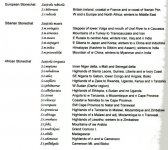Niels,
Basically true. The SM played around with the old Common Stonechat (S. torquata) in the 1996 version listing, among other things, the accepted only by them African Stonechat (S. axillaris), as well as this one. They then relumped it with the Common Stonechat. Now, they have again split the old S. torquata into the three Clement's accepted species, i.e., European Stonechat, Siberian Stonechat and African Stonechat. The other authoritative world list (Howard & Moore) does not presently recognize the taxonomic treatment afforded by both the current SM and Clement's. For HM, the three species are all treated in Common Stonechat (S. torquata). Their problem, however, is not so much whether or not they might believe that there should be splits, but rather they are still not certain that the taxonomic treatment of the subspecies associations to the three species is correct and are, therefore, awaiting further scientific corroboration to this effect.





